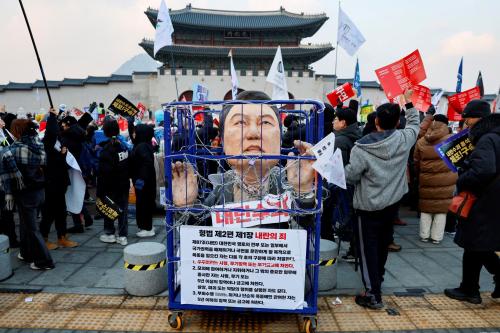This post was updated on March 5, 2024.
Once again, the nation will turn its attention to an annual ritual that, like American politics itself, runs the gamut from inspiring to ridiculous—the State of the Union.
The State of the Union was originally called the Annual Message. Although President George Washington gave the first one in person before Congress in 1790, the message was delivered in writing until the early part of the 20th Century—at which point President Woodrow Wilson revived the tradition that has lasted until today. Along the way, the State of the Union went from radio to television to the Internet and picked up a formal response from the political party out of power. While the State of the Union has provided us with some of our most uplifting and sublime moments, the various responses have provided ample fodder for late-night comedians.
Let’s start with the sublime. Consider, for instance, Franklin Roosevelt’s 1941 State of the Union in which he evoked “the Four Freedoms”—freedom of speech and worship and freedom from want and fear—as a powerful justification for what was to be America’s role in a world at war.
Then there was Lyndon Johnson’s declaration in his 1964 State of the Union that the coming Congress would be remembered as the one that “declared all-out war on human poverty.”
More recently, in his 2002 State of the Union address, following the 9/11 disaster, President George W. Bush declared North Korea, Iran and Iraq “the axis of evil.”
It was President Ronald Reagan who began the tradition of seating a worthy American in the balcony next to the First Lady in order to make a point. In 1982 he invited Lenny Skutnik, a hero of a plane crash in the Potomac and said of him—“Just two weeks ago, in the midst of a terrible tragedy on the Potomac, we saw again the spirit of American heroism at its finest the heroism of dedicated rescue workers saving crash victims from icy waters. And we saw the heroism of one of our young Government employees, Lenny Skutnik, who, when he saw a woman lose her grip on the helicopter line, dived into the water and dragged her to safety.”
Fourteen years later Bill Clinton introduced another hero to America and managed to simultaneously score political points when he introduced Richard Dean as follows. “He is a 49 year-old Vietnam veteran who’s worked for the Social Security Administration for 22 years now. Last year he was hard at work in the Federal Building in Oklahoma City when the blast killed 169 people and brought the rubble down all around him. He reentered that building four times. He saved the lives of three women. He’s here with us this evening, and I want to recognize Richard and applaud both his public service and his extraordinary personal heroism. But Richard Dean’s story doesn’t end there. This last November, he was forced out of his office when the government shut down. And the second time the government shut down he continued helping Social Security recipients, but he was working without pay. On behalf of Richard Dean and his family, and all the other people who are out there working every day doing a good job for the American people, I challenge all of you in this Chamber: Never, ever shut the federal government down again.”
While most State of the Union addresses are uplifting, well-orchestrated and assert, whether true or not, that the state of the union is sound, in President Gerald Ford’s 1975 State of the Union he departed from this script to declare “The state of the union is not good.”
Most of the time these events have been well scripted and carefully produced.
The same cannot be said of the responses. In recent years the responses have been, well, less than sublime. In response to Ronald Reagan’s 1985 State of the Union, the Democrats ran a ten-minute tape featuring Democratic elected officials talking to citizens in focus groups. In between the segments, a young Governor Bill Clinton told the country “clearly there’s a Democratic Party in America that’s alive and well.” After the Republican landslide in 1984—the entire Democratic response, awkward and hard to watch, (especially the average Americans saying that they were, indeed, better off under Reagan)—did not manage to convince anyone that the Democratic Party was alive and well.
Republicans have had their own response debacles. Often the person chosen to deliver the Party’s response is a rising star—at the time. Just five years ago, the rising star who responded to President Obama’s 2010 State of the Union was Virginia Governor Bob McDonnell—who has since been convicted on eleven counts of corruption and is on his way to jail.
And then there are the embarrassing screw-ups that make it into opening sketches for Saturday Night Live. In response to the 2011 State of the Union, the Republicans offered two responses – one from the Tea Party. Michele Bachmann was chosen to give the latter and looked at the wrong camera for the entire time. A few days later comedienne Kristin Wiig did a parody of “crazy eyes” Bachmann on SNL. It’s probably safe to say that the parody was seen by more people than was the original response.
Of course, it was just two years later that SNL had another Republican response to parody, featuring Taran Killam as a dry-mouthed Marco Rubio dashing for a cure for a speech-induced thirst.
But if the official responses have been less than stellar the unofficial ones have sometimes been downright bizarre. Take the case of Congressman Michael Grimm who was, like many of his colleagues, hanging out on the balcony of the Cannon House office building after last year’s State of the Union. NY1 Reporter Michael Scotto asked him about the State of the Union and then followed up with a question about the Congressman’s campaign finance irregularities. Grimm refuses to answer, walks away and then, with the camera still running tells the reporter “…if you ever do that to me again I’ll throw you off this f—— balcony.” Grimm is no longer in Congress.
And finally, most State of the Union addresses are exercises in polite partisanship; the president’s party stands up and claps at his words, and the other party sits glued to their seats in protest. Sometimes someone boos or shouts out an insult, but most of the time, the ritual of standing and clapping, or not, is the limit. But in 2020, following Donald Trump’s address, House Speaker Nancy Pelosi engaged in a bit of unprecedented political theater. That State of the Union took place one day before the end of Trump’s impeachment trial, which Trump did not mention. At the end of the speech, as Trump was looking from side to side acknowledging the applause, Vice President Mike Pence and Speaker Nancy Pelosi, seated as per custom behind the president, stood up. While Pence clapped, Pelosi looked down at her desk, took up a few pages of the president’s speech at a time, and slowly and deliberately ripped them up. Afterward, she commented “He shredded the truth, so I shredded his speech. What we heard last night was a disgrace.”
So, there you have it—from the four freedoms to threats of violence and political theater. The State of the Union is just like the country it’s about.
The Brookings Institution is committed to quality, independence, and impact.
We are supported by a diverse array of funders. In line with our values and policies, each Brookings publication represents the sole views of its author(s).


Commentary
State of the Union Preview: Best (and Worst) Moments from History
January 16, 2015